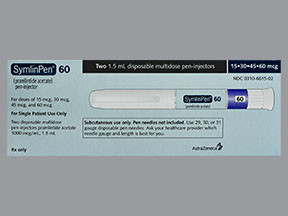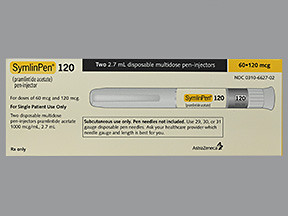PRAMLINTIDE INJECTOR - INJECTION
PHONETIC PRONUNCIATION: (PRAM-lin-tide)
COMMON BRAND NAME(S): Symlinpen
GENERIC NAME(S): pramlintide acetate
Uses
USES: Pramlintide is used with mealtime insulin and a proper diet and exercise program to control high blood sugar in people with type 1 and type 2 diabetes. It is used when patients who are already using insulin need better blood sugar control. Controlling high blood sugar helps prevent kidney damage, blindness, nerve problems, loss of limbs, and sexual function problems. Proper control of diabetes may also lessen your risk of a heart attack or stroke. Pramlintide acts like a certain natural substance called amyrin, which lowers blood sugar. This drug works by slowing the movement of food through your stomach. It also decreases your appetite and the amount of sugar your liver makes. Pramlintide does not replace insulin, but it may lower the amount of insulin you need.
How to use PRAMLINTIDE INJECTOR - INJECTION
HOW TO USE: Read the Medication Guide provided by your pharmacist before you start using pramlintide and each time you get a refill. If you have any questions, consult your doctor or pharmacist. Inject this medication under the skin of the thigh or abdomen just before each main meal. Do not use pramlintide if your blood sugar is too low, if you are planning to eat a small meal (less than 250 calories or 30 grams of carbohydrate), or if you are skipping a meal. The liquid in the pre-filled injector is stronger than the liquid in the vial. Make sure you are using the correct product. Do not switch between products unless directed by your doctor. Make sure you learn from your health care professional how to measure your dose and inject this drug. Always use a new needle for each injection. Consult your doctor or pharmacist if you have any questions. If you are storing this drug in the refrigerator, remove it and allow it to come to room temperature before injecting. Before using, check this product visually for particles or discoloration. If either is present, do not use the liquid. Before injecting each dose, clean the injection site with rubbing alcohol. It is important to change the location of the injection site daily to avoid problems under the skin. Never mix pramlintide and insulin in the same syringe or at the same injection site. Inject pramlintide in an area that is at least 2 inches (5 centimeters) away from your insulin injection site. Your dosage is based on your medical condition, use of other medications, and response to treatment. To reduce the risk of nausea, your doctor may direct you to start at a low dose of pramlintide and gradually increase the dose. Your doctor may also direct you to lower your insulin dose and to check you blood sugar more often. Do not change your dosage without consulting your doctor. Use this medication regularly in order to get the most benefit from it. Do not share your pen device with another person, even if the needle is changed. You may give other people a serious infection, or get a serious infection from them. Learn how to store and discard medical supplies safely.
Side Effects
Precautions
Interactions
Overdose
Images
Reviews
Warning
WARNING: Pramlintide may increase the risk of very low blood sugar when used with insulin, particularly in patients with type 1 diabetes. This reaction is most likely to occur within 3 hours after an injection. Your doctor may decrease your insulin dose when you start pramlintide. Low blood sugar makes it hard to think clearly, drive a car, use heavy machinery, or safely participate in other activities that include a risk of hurting yourself or others. (See also Side Effects and Precautions sections.)
Disclaimer
IMPORTANT: HOW TO USE THIS INFORMATION: This is a summary and does NOT have all possible information about this product. This information does not assure that this product is safe, effective, or appropriate for you. This information is not individual medical advice and does not substitute for the advice of your health care professional. Always ask your health care professional for complete information about this product and your specific health needs.


No Reviews Yet